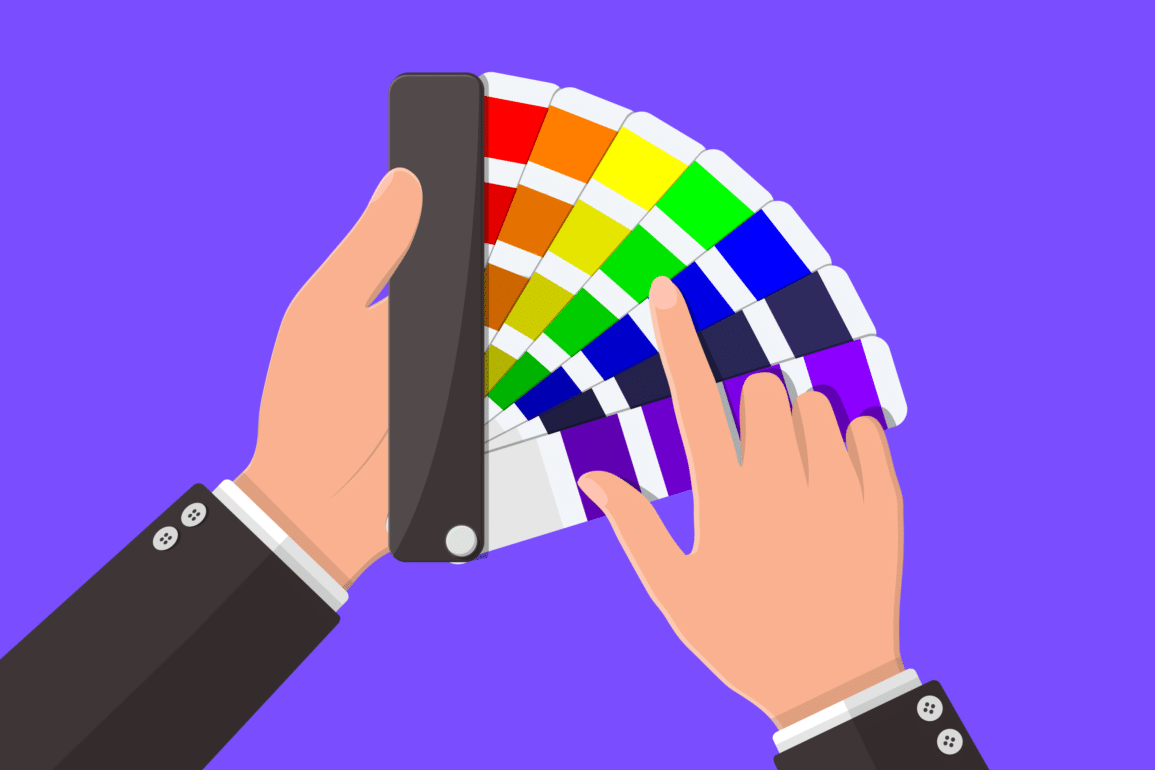Rainbow colors: Exploring the colors of the rainbow

Rainbow colors swept over the sky at the end of a storm represent one of the most magical natural phenomena we have. No matter your age, spotting the colors of the rainbow amongst the clouds will always be enough to fill your heart with joy and wonder.
Rainbow colors are no accident. A rainbow is actually a meteorological phenomenon caused by the scientific elements of reflection, refraction, and light dispersion in water droplets through the sky.
While this event is a natural one, the conditions of the atmosphere need to be just right for a rainbow to be possible – which is why we don’t see one every day.
As one of the more eye-catching events mother nature has to offer, rainbows have become a source of inspiration for countless artists and groups over the years.
Let’s take a closer look at the colors of the rainbow.
Rainbow colors: What is a rainbow?
Most people have spotted a rainbow at some point during their lives. The event is relatively common, though this doesn’t make it any less magical. Rainbows are more science than art in terms of their origins.
A meteorological event, a rainbow is what happens when the rays of the sun pas through millions of tiny molecules suspended in the atmosphere.
Since both water and sun need to be present for a rainbow to form, this is why you generally won’t see a rainbow on a completely clear or sunny day.
The rainbow colors we see are the produced by the “refraction” of light through the raindrops or water in the atmosphere. Similar to light moving through a prism, when sunlight hits the water molecule at a certain angle, it creates the various colors of the visible spectrum in the deflecting light waves.
Interestingly, rainbows are a kind of optical illusion. If you were to fly to the spot in the sky where you see the rainbow, there wouldn’t be anything there. The appearance of a rainbow depends entirely on where you’re standing.
Defining the rainbow: Why is the rainbow curved?
Rainbows are produced by the refraction and reflection of light. These are phenomena which change the direction of a light wave. While a refracted wave might appear curved, the exact position and shape of a rainbow is determined by a number of things.
Scientists measure the radius of rainbows by looking at the “refractive index” – the measure of how much a ray of light bends as it passes from water to the air, or vice versa. Certain types of water will have a higher refractive index than others.
For instance, rainbow colors formed by sea spray are smaller than rainbows created by the rain.
Interestingly, in most cases, a rainbow isn’t just a “bow” or curved line. A rainbow is a full circle. If you were in an aircraft, you might be able to see a fully circular rainbow from a distance.
However, viewers on the ground can only see a portion of the rainbow, reflected by raindrops above the horizon. Because everyone has a slightly different horizon, the full rainbow is never visible.
Another point to note – no-one sees the same rainbow. Each person has a different “antisolar” point – which represents the middle of the rainbow.

Who discovered the colors of the rainbow?
The question of who discovered the rainbow first is highly disputed. Most people attribute the official discovery of the rainbow to Isaac Newton, who began a series of experiments using prisms and sunlight in 1660.
Newton scientifically established the visual spectrum, in a way which allowed us to name and understand the various colors of the rainbow.
However, just because Newton defined the rainbow as we know it today doesn’t necessarily make him the initial person to discover it. Aristotle, the famous philosopher, began musing about the potential origins of the rainbow way back in 350 BC.
Later in history, Seneca the Younger, a Roman philosopher, built upon the ideas developed by Aristotle in his book Naturales Quaestiones, in 65 AD.
Seneca was actually pretty close to the truth with his assumptions about the origins of rainbows, and he even predicted the discovery of the prism effect established by Newton later.
A philosopher named René Descartes also expanded on the concept of the rainbow a little before Newton, making a public statement about how refraction and light reflection was the reason behind the optical phenomenon.
While thinkers and philosophers, naturalists, and scientists have all examined and explored the concept of the rainbow effect throughout history, certain elements of their assumptions remained the same.
Most experts agreed to create the stunning burst of color we see in the sky, we needed both sunlight, and water vapor.
What are the different kinds of rainbow?
Interestingly, there are actually various kinds of rainbow, though most share the majority of the same rainbow colors. All of these rainbows are created by the same refraction and reflection process mentioned above, though there are some differences in the development of the spectrum.
Some of the most common kinds of rainbow variation are:
Glow
The atmosphere directly opposite to a rainbow, usually facing towards the sun, will usually be “glowing.” This glow appears when drizzle or rain is falling between the sun and the viewer. The glow is created by the light passing through the raindrop.
Double rainbow
Sometimes, you may see a double rainbow, which is when a faint, additional rainbow may show above the primary phenomenon. Double rainbows happen when light is reflected twice within the same raindrop. As a result of this second reflection, the spectrum of the secondary rainbow may be reversed.
Twinned rainbow
Separate to a double rainbow, a twinned rainbow is two distinctive rainbows created from a single endpoint. This is what happens when light hits an air mass with different shapes and sizes of water drops in different areas.
Reflection rainbow / reflected rainbow
A reflection rainbow is when the rainbow colors appear above a body of water. A primary rainbow will be reflected by the water, while the reflected light creates a fainter reflection rainbow. The reflection rainbow will often appear to stretch above the primary.
In a reflected rainbow, the rainbow appears directly on the surface of a body of water, created by rays of light hitting the water’s surface.
Higher order rainbows
Inside a raindrop, there are various angles at which light can be reflected. The order of a rainbow is the reflective number of the phenomenon. A primary rainbow is a first-order rainbow, while secondary rainbows are second-order.
Tertiary rainbows, for instance, appear to viewers facing towards the sun (a third-order rainbow). However, tertiary rainbows can be difficult to see. The viewer is looking towards the sun in this case, and the center of the rainbow isn’t an anti-solar point, but the sun itself.
There are “quaternary” rainbows, which can be very difficult to see, and even higher-order rainbows than this, often discovered by scientists.
What are the colors of the rainbow?
The colors of the rainbow are the shades of the “visual spectrum” created by light. The idea there are seven visible colors in the rainbow is still common among most people. At a glance, this may seem true, but closer inspection usually shows there are a lot more than seven individual hues.
Rainbows are actually made up of a myriad of individual spectral colors mixing and overlapping. However, the basic sequence for a primary rainbow is always the same.
Here are the rainbow colors in order:
Red
Orange
Yellow
Green
Blue
Indigo
Violet
The colors of the rainbow are created by individual wavelength sizes. Red is the longest wavelength, usually around 780nm, while violet is the shortest at 380nm.
While it’s possible to see a huge variety of colors within a rainbow on closer inspection, it’s easiest to simply focus on the 7 colors of the rainbow in order if you’re struggling to remember them.
The first color of the rainbow: Red
Red is the first detectable color in the visual spectrum, and the first color of the rainbow. It’s one of the shades we’re most capable of detecting with the human eye. It’s even possible to have very specific kinds of rainbow which show red more than any other color.
Red has emerged as a meaningful color from a psychological perspective over the years. Many people associate red with concepts of anger and aggression. The shade is also sometimes connected with danger, passion, and love.
Some cultures use the color red to symbolize life, like the color of our blood, or the color of the heart.
The second color of the rainbow: Orange
In the segment of the rainbow blending from red to yellow, we can often see the discernable hue of orange. The second color of the rainbow, orange is often harder to distinguish than red, as the primary color stands out more on the visual spectrum.
Orange is a bright and vibrant color, with minimal negative connotations in most cultures. Throughout the world, many people associate this color with vitality, positivity, and joy.
Orange can symbolize concepts like enthusiasm and excitement, and it’s often considered to be a fresh and compelling shade.
The third color of the rainbow: Yellow
Following orange, the colors of the rainbow gradually shift into yellow. When the atmosphere is just right, and you’re standing at the perfect angle to view your rainbow, the color can be particularly strong.
However, if the intensity of your rainbow is low, you might not notice the third color of the rainbow at all.
Yellow is another shade with a lot of positive connotations in color psychology. The hue is often connected with the concepts of joy and youthful. You may also link yellow to concepts of wealth and abundance.
Yellow has begun to take on some negative meanings thanks to our use of the shade on various hazard signs. Although the color usually more commonly linked to creativity and happiness.
The fourth color of the rainbow: Green
Similar to yellow, the green in your rainbow might be harder to see from some angles than others. The fourth color of the rainbow blends into the shades of yellow and blue. The depth with which you’ll be able to see this color will depend on the angle you’re standing at, and the formation of the rainbow.
From a psychological perspective, the color green has developed a lot of closer connections with nature and the environment. We associate green with freshness and growth.
Over the years, the color has also taken on additional meanings, like vigor, wellbeing, and even wealth. Your position in certain communities around the world may influence how you perceive green.
The fifth color of the rainbow: Blue
Blue is the fifth color of the rainbow, but it’s one of the harder shaders to find among the various shades you’ll see depicted in the sky. Because the sky itself usually appears blue, it’s harder to perceive the blue tones between the green and indigo of the rainbow.
Blue is the most popular color in the world, and it has a number of meanings attached to it from a psychological perspective. Some are more positive than others. Many people associate blue with reliability, royalty, and calm.
Blue can also be linked top negative feelings like boredom and depression, depending on the shade of choice.
The sixth color of the rainbow: Indigo
Because indigo is a type of blue, the sixth color of the rainbow can sometimes be confused with the fifth. The main difference here is the intensity of the shade. Indigo is an intense form of blue which also has connections to slightly purple shades.
Some individuals believe there are only 6 rainbow colors because they struggle to perceive indigo.
Indigo, like blue, has a number of psychological links associated with it. Many people associate this color with concepts like fantasy and dreams, but it can also stand for respect and individuality.
The last color of the rainbow: Violet
The color with the shortest wavelength in the rainbow, violet is one of the most impressive colors of the rainbow, highlighting the movement of the shades from warm to colder tones. In some cases, this shade can be harder to see, when the shorter wavelengths in the sky have already been scattered.
Violet and purple shades can be associated with everything from royalty and indulgence, to the spiritual world and magic.

When do the colors of the rainbow change?
Because we only have one “visible spectrum” responsible for creating the colors of the rainbow, the majority of rainbows will show the same colors. However, there are instances wherein we might see slightly different shades produced by the refraction and reflection of light.
For instance, this can happen with a:
Supernumerary rainbow
A unique form of rainbow, the supernumerary rainbow is a thin, pastel-colored bow which appears just beneath the inner arch of the primary rainbow. This is what happens when the light rays in the air interact with smaller, similarly-sized droplets of water.
In a supernumerary formation, the rays of reflected light interact with destructive and constructive interference. The waves of light are reinforced, or cancelled out, leading to narrower bands and lighter hues.
Red rainbow
One of the few ways in which the colors of the rainbow are drastically changed. In a red rainbow (monochrome rainbow), appearing at sunset or sunrise, sunlight is travelling further in the atmosphere. Shorter wavelengths responsible for creating colors like violet and blue, are scattered.
The unique refraction and reflection of light means only long-wavelength shades of red are visible in a red or monochrome rainbow.
Fogbow
As you might imagine, a fogbow is the name used when the colors of the rainbow are depicted through fog, rather than rain. The light in a fogbow is reflected and refracted by fog and can sometimes appear in clouds (a cloudbow).
Because the water droplets in both clouds and fogs are smaller than those of raindrops, the colors in the rainbow are much fainter. In some cases, there are only a few detectable colors available, with reddish tinges on the outer edge, and bluish tinges on the inner edge.
Colors of the rainbow: FAQ
How do you remember the colors of the rainbow?
From an early age, many of us are taught mnemonic phrases to help us remember the colors of the rainbow, like Richard Of York Gave Battle In Vain. There are also popular songs to help remember the colors of the rainbow, but they rarely place the shades in order.
Is indigo the same as blue?
Some people assume there are only six colors in the rainbow because they see indigo as either a type of blue, or purple. Indigo is a vivid blue/purple color which lies somewhere in the spectrum alongside violet and blue. This shade is a distinctive part of the visual spectrum on its own.
Is pink in the rainbow?
Popular songs like “I can sing a rainbow” usually include the shade “Pink” in the depiction of a traditional rainbow. However, pink doesn’t appear to be a specific color within the natural rainbow. This is because pink doesn’t naturally appear in a prism’s rainbow.
Can you see rainbows from space?
Rainbows appear on earth when the rays of the sun strike droplets of water in the atmosphere, causing light to refract and bounce back towards the viewer. There are various specific atmospheric conditions which must come together for a rainbow to appear in space, so it’s very rare to see one.
What are the 7 colors of the rainbow?
The colors of the rainbow are red, orange, yellow, green, blue, indigo, and violet. There are a total of 7 colors visible in most rainbows.
What does a rainbow symbolize?
The magical phenomenon of the rainbow has taken on a great deal of meaning for many cultures. Rainbows can be symbols of hope and pride. They can also be symbolic of joy and various other positive concepts.
What does it mean when you see a rainbow with no rain?
A rainbow with no rain doesn’t mean there aren’t any water droplets in the sky. There is likely to be waterfall somewhere in the area, or the rain might have ended somewhere nearby. Rainbows can only occur when moisture is present.
Celebrating the rainbow colors
The rainbow is one of the most amazing, yet common natural phenomena we can see in the world today. All over the world, these incredible visual masterpieces have emerged as symbols of inspiration and hope for entire cultures.
Though the origins of the rainbow may be somewhat simple (and scientific), it’s fair to say most of us believe rainbows have their own unique kind of magic.
Fabrik: A branding agency for our times.
















